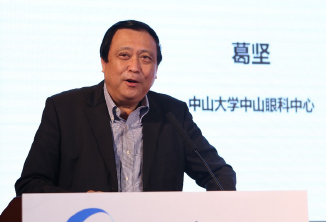Professor Ge Jian, Chief Scientist of the National 973 Project, discusses the promising market for Xi’an-made intraocular lenses
This interview was conducted October 13 at the National Key R&D Program key special project kick-off meeting and biomedical technology industrialization development forum held in Xi’an.
Professor Ge Jian, Chief Scientist of National 973 Program, Honorary Chairman of Ophthalmology Branch of Chinese Medical Association, Former Director of Zhongshan Ophthalmology Center of Sun Yat-Sen University, Former Director of State Key Laboratory of Ophthalmology, and Doctoral Supervisor, discusses current cataract treatments and the development of domestic intraocular lens products.

Reporter: Many experts on the forum today talked about the rates of cataract surgery in our country. Could you please elaborate on this?
Ge Jian: The cataract surgery indicator (CSI) measuring operations per million people is an indicator that measures the quality of public medical care. The CSI operation rate in developed countries in Europe and the United States is between 5,000 and 10,000. This is very high. Levels above 10,000 means that almost all cataracts have been removed by surgery. Our CSI last year was 2200 people per million, which is a big jump from the 500 a decade ago. The cataract surgery rate in China’s big cities is the same as that in developed countries.
Reporter: How are cataracts treated?
Ge Jian: The most important treatment surgery. Cataract surgery is now very mature. Partial vision can be restored through surgical incisions and replacement of intraocular lenses. The Chinese government has invested a lot in the treatment of cataracts, with 2 billion yuan already allocated. In addition, some non-governmental charitable organizations and hospitals also go to poor and remote areas to treat cataracts. In 2016, 1.2 million cases of cataract surgery were performed in China.
Reporter: Among those 1.2 million cataract surgeries, what is the ratio of imported intraocular lenses to domestic intraocular lenses?
Ge Jian: As far as I know, most cataract surgeries in our cities use imported intraocular lenses. Each operation costs 3,000 to 5,000 yuan. If high-end intraocular lenses are used, the price increases to over 10,000 yuan. Domestic intraocular lenses are currently mainly used in cataract surgery in rural and remote areas. China produces almost no high-end intraocular lenses. Even if there are one or two factories in China, the output is very low and the manufacturing cost is very high to create products similar to imports from Alcon and Bausch & Lomb.
Cataract treatment in China faces several challenges:
1. The imbalance between urban and rural areas requires a lot of government support. Urban incomes are high, and the surgical treatment rates are also high. Low incomes in rural and poor areas, and low surgical coverage have caused many elderly patients to die.
2. The localization rate of related equipment and materials for the treatment of cataracts is too low. According to the Made in China 2025 plan, there is an urgent need to increase this rate rate.
3. After a domestic high-end intraocular lens is produced, it also needs to be marketed effectively.
Reporter: How do you see the future impact of domestic intraocular lenses, and the emergence of domestic high-end intraocular lens products?
Ge Jian: Firstly, the price will definitely come down, and secondly, the quality will be better than foreign brands, and therefore the first choice of patients.
I think the domestic intraocular lenses can be made in two steps. The first step is to follow and reinvent the most advanced international brand products. The fourth-generation mature hydrophobic acrylate material can be used to manufacture high-end intraocular lenses.
The second step is to take the lead and launch the most advanced fifth-generation intraocular lens product.
Xi’an Eyedeal presents a good example. After receiving 10.43 million yuan in the National Key R&D Program project, the company has found a technical route for a fifth-generation intraocular lens. With an additional 30 million yuan in funding, personnel, equipment, and production lines, it can pass clinical verification, mass production and go to market as soon as possible.
Today I listened to the introduction of Xi’an Eyedeal. The fifth-generation intraocular lens they developed using cross-linked polyolefin synthetic materials has good optical properties, good biocompatibility, good abrasion resistance, low post-inflammation, and vision. With the advantages of a wider angle and smaller incision, experts and patients have responded well, and the price can be reduced by half. How can patients not welcome products like this?
I think this product is very good, with big market potential. If the research and development are in place, and everything goes according to plan, it can completely occupy European and American markets.
Expert profile: Ge Jian is a Professor of ophthalmology, doctoral supervisor and former director of Sun Yat-sen University’s Zhongshan Ophthalmology Center, former director of the State Key Laboratory of Ophthalmology, visiting professor at the University of Houston, and honorary professor of Hong Kong Polytechnic University, the Chief Scientist of National 973 Project, Honorary Chairman of Ophthalmology Branch of Chinese Medical Association, Vice Chairman of Ophthalmology Branch of Chinese Medical Doctor Association, former head of Glaucoma Group of Chinese Ophthalmological Association, Chairman of Guangdong Academy of Ophthalmologists, Standing Director of World Glaucoma Association, Deputy Editor-in-Chief of Chinese Journal of Ophthalmology, the Chinese Journal of Experimental Ophthalmology and an editorial board member of Clinical and Experimental Optometry and Journal of Glaucoma.